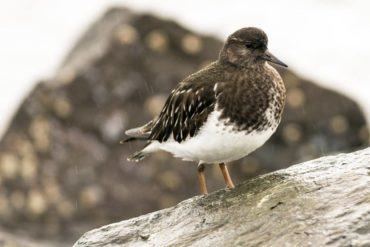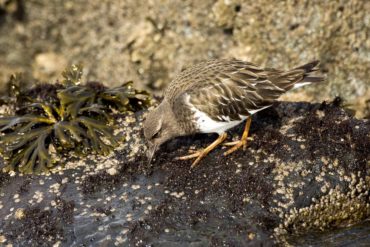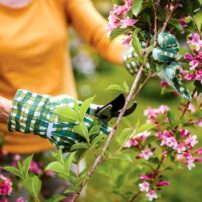
As winter gives way to spring, migratory marine birds are journeying north to Arctic breeding grounds, including numerous species of ducks, alcids, loons, gulls and shorebirds. The latter consists of birds that live on sandy or rocky beaches and mudflats.
Some shorebirds are solitary, while others travel together. Multiple shorebird species often congregate on feeding grounds and birders enjoy the challenge of sorting through them. Stunning displays of migrating flocks can number in the thousands.
Most of West Sound’s shorebirds breed on the Arctic tundra. Many spend the winter months here, while others pass through during migration.
Shorebirds come in various sizes. Some are nearly as small as sparrows, while others are as big as crows. Bill length corresponds to their method of foraging. Some shorebirds have short bills for feeding on surface invertebrates and others have long bills to probe for creatures that live in mud and wet sand.
A shorebird that is easy to identify and sure to turn heads is the black turnstone. Known to few outside the birding world, the black turnstone is a signature species of rocky coastlines, wave-battered jetties, piers and breakwaters. Locally, it’s an uncommon species that with a little effort can be found in West Sound.
A medium-sized member of the sandpiper family, the black turnstone is slightly smaller than a city pigeon. The plump-looking shorebird has a short bill, orange legs and unique black-and-white plumage. The upperparts are black and the underparts are a contrasting white. Striking black-and-white striping is visible on the wings and tail during flight.

The black turnstone uses its coloring as camouflage. By pretending to be a rock, it’s often undetectable to a hungry peregrine falcon passing over. It can also go unnoticed by even experienced birders until it moves.
The world’s other turnstone species is the ruddy turnstone. With colors that resemble a calico cat, this rare visitor to Puget Sound is occasionally found in late summer on the southeastern corner of Bainbridge Island alongside its cousins.
Unlike the ruddy turnstone, which can be found on six continents, the black turnstone is limited to the Pacific Coast of North America. It breeds on the coastal Arctic tundra and winters along inner and outer shorelines from southern Alaska to southern Baja in California.
In West Sound, black turnstones are most-often found from late fall to early spring as migrants pass through and small flocks stay for the winter. They are nearly absent from Puget Sound in May and June.
Rocky Puget Sound shorelines offer the best possibilities for viewing black turnstones. They are most-often seen around southeastern Bainbridge Island and the South Kitsap area, particularly the beaches of Yukon Harbor and Port Orchard. Other fairly reliable locations include Liberty Bay in Poulsbo, Port Gamble and the Brownsville Marina.
Turnstones primarily forage on rocks and beaches that are covered in seaweed. They feed on limpets and acorn barnacles, which they pry from rocks with their strong bills. They also eat crustaceans.
When foraging on beaches, turnstones sometimes turn stones over while searching for prey, which is how they get their name. During the breeding season, other food sources include insects, seeds and berries.
Black turnstones nest on the Alaska tundra, never more than a mile from the coast. A pair will return each year to the same scrape on the ground for their nest. Both parents incubate the clutch of four eggs for at least 22 days and fiercely defend them against gulls and jaegers.
Shortly after hatching, the chicks are able to catch insects themselves while under the watchful eye of their parents. The female departs after two weeks, leaving the male to care for the young until they are independent. Juveniles are proficient flyers by one month of age.
In September 2019, a report published in Science magazine revealed that scientists have determined that North America has lost 3 billion birds since 1970, primarily due to habitat loss. Climate change is presenting a new threat. Even common species are in steep decline.
According to the Cornell Lab of Ornithology, shorebirds in North America have declined by 37 percent in the last 40 years. Black turnstones are among those affected. It’s considered an “early warning” species of concern by Audubon Washington.
Degradation and loss of habitat force black turnstones to nest and forage in less than ideal areas, contributing to their decline. Contamination of shorelines is another problem. Scientists are working to mitigate these threats in part by studying migration patterns and the locations of important stopovers so they can determine which areas need the most protection.
Black turnstones are delightful birds that add an element of interest to our shores. Indicators of climate change and quality of marine habitat, these and other shorebirds are trying to get our attention. Let’s hope everyone is listening.
























Comments